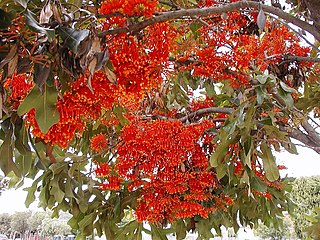
Stenocarpus is a genus of about 22 species of flowering plants in the family Proteaceae. They are trees or shrubs with variably-shaped leaves, zygomorphic, bisexual flowers, the floral tube opening on the lower side before separating into four parts, followed by fruit that is usually a narrow oblong or cylindrical follicle.
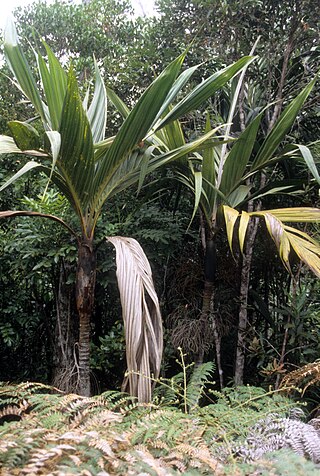
Basselinia is a genus of flowering plant in the family Arecaceae. The entire genus is endemic to the Island of New Caledonia in the Pacific. In some molecular phylogenetic analyses, Hedyscepe from Lord Howe Island is nested in Basselinia.
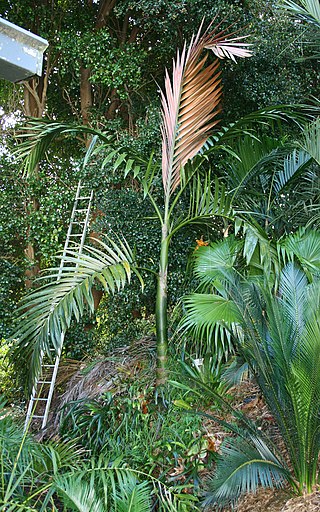
Chambeyronia is a genus of flowering plants in the family Arecaceae. It contains nine species, all endemic to New Caledonia:

Geissois is a genus of trees and shrubs in the plant family Cunoniaceae. It includes about 19 species mostly found in New Caledonia, but also in Fiji, Vanuatu, and the Solomon Islands. Leaves are opposite, palmate with 3-9 leaflets, with entire margin and intrapetiolar stipules. The inflorescences are simple racemes and bottle-brush like. The flowers have four red sepals, lacking petals, with many long red stamens. The fruit is a capsule, the seeds flat and winged. The genus includes several nickel hyperaccumulator and one aluminum hyperaccumulator, Geissois polyphylla.
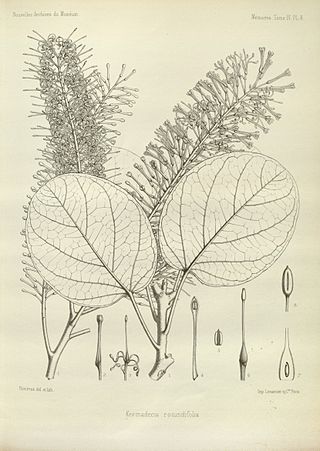
Kermadecia is a genus of flowering plants in the family Proteaceae. The genus comprises eight species of rainforest trees from New Caledonia, Fiji, and Vanuatu. Its closest relative is Euplassa from South America.
Pancheria humboldtiana is a species of shrub in the family Cunoniaceae. It is endemic to New Caledonia where it is rare and found only on a few mountains.
Pancheria multijuga is a species of shrub in the family Cunoniaceae. It is endemic to New Caledonia, where it is rare and found only on a few mountains.
Pancheria robusta is a species of shrub in the family Cunoniaceae. It is endemic to New Caledonia, where it is rare and found only on a few mountains.
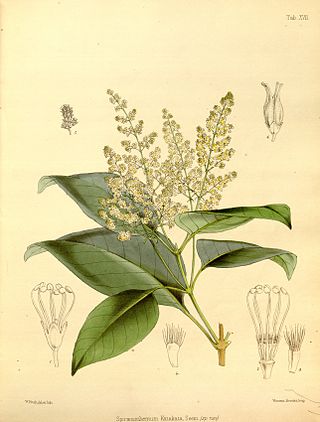
Spiraeanthemum is a genus of trees and shrubs in the family Cunoniaceae. it includes about 19 species from Australia, New Guinea, Solomon Islands, New Caledonia, Vanuatu, Fiji and Samoa. Leaves are simple, opposite or whorled, with toothed or entire margins. Inflorescences are paniculate, flowers unisexual or hermaphrodite, and the fruits are follicular with free carpels. It belongs to the tribe Spiraeanthemeae, and now includes the species formerly placed in Acsmithia.
Pterophylla ouaiemensis, formerly known as Weinmannia ouaiemensis, is a species of plant in the family Cunoniaceae. It is endemic to New Caledonia.

Xanthostemon is a genus of plants in the myrtle family Myrtaceae, first described in 1857 by the German–born Australian botanist Ferdinand von Mueller. The genus is distributed across Malesia, Papuasia and northern Australia. The genera Pleurocalyptus and Purpureostemon from New Caledonia are morphologically close to Xanthostemon.

Cunonia is a genus of shrubs and trees in the family Cunoniaceae. The genus has a disjunct distribution, with 24 species endemic to New Caledonia in the Pacific, and one species in Southern Africa. Leaves are opposite, simple or pinnate with a margin entire to serrate. Interpetiolar stipules are often conspicuous and generally enclose buds to form a spoon-like shape. Flowers are bisexual, white, red, or green, arranged in racemes. The fruit is a capsule opening first around the base then vertically, seeds are winged.
Virotia is a genus of six species of flowering plants in the family Proteaceae. The genus is endemic to New Caledonia with six species that were once placed in Macadamia. Its closest relatives are the Australian Athertonia and the Asian Heliciopsis. The genus is named after Robert Virot, pioneer of ecological studies in New Caledonia and author of a monograph of New Caledonian Proteaceae.

Codia is a genus of trees and shrubs in the family Cunoniaceae. The genus is endemic to New Caledonia in the Pacific and contains 15 species. The leaves are opposite or whorled, simple, and the margin usually entire. The flowers are arranged in capitula. the ovary is inferior. The fruit is indehiscent and is covered with woolly hairs.
Eucarpha is a genus of flowering plant of the family Proteaceae, endemic to New Caledonia. Two species are recognised. Up to 1975, these were classified within the genus Knightia until Lawrence Johnson and Barbara G. Briggs recognised their distinctness, particularly their prominent bracts, in their 1975 monograph "On the Proteaceae: the evolution and classification of a southern family". Nomenclatural combinations for these two species in the genus Eucarpha were published in 2022.

Deplanchea is a genus of about eight species of tropical rainforest trees, constituting part of the plant family Bignoniaceae.
Dubouzetia is a genus of about eleven species known to science, growing from shrubs up to large trees, in Papuasia and Australasia and constituting part of the plant family Elaeocarpaceae.
Hooglandia ignambiensis is a species of trees in the family Cunoniaceae. It is endemic to New Caledonia and the only species of the genus Hooglandia. It is named after Dutch botanist Ruurd Dirk Hoogland.
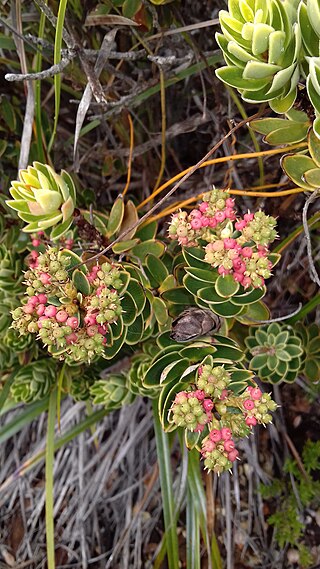
Cyathopsis is a genus of shrubs in the family Ericaceae. The genus is endemic to New Caledonia in the Pacific and contains three species that have previously been included in Styphelia. It is related to genera such as Leucopogon, Lissanthe and Styphelia.

Pterophylla is a genus of trees of the family Cunoniaceae, with species found growing naturally in Madagascar, Malesia, Papuasia, and the Pacific Islands, formerly included in Weinmannia.












